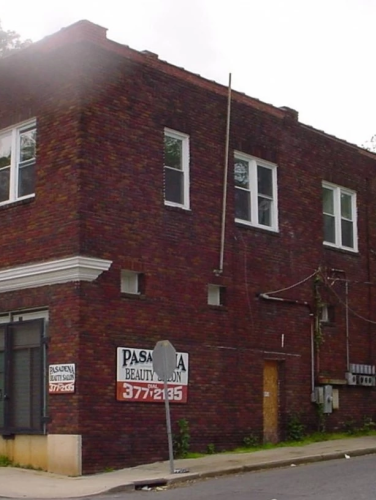
Grand Theater
(ca. 1937)
The Grand Theater is a rare artifact from the Jim Crow segregation era that prevailed in Mecklenburg County through most of the 20th century. (Open Ended)
333 Beatties Ford Road, Charlotte, NC 28216
The Grand Theater is Mecklenburg County’s sole surviving movie theater that served an exclusively African American clientele during the period of Jim Crow segregation. Like other southern states, North Carolina prohibited the integration of Black and White citizens within places of public accommodation, often requiring the construction of so-called “separate but equal” facilities or creation of separate seating sections in order to comply with the laws. The Grand Theater was one of only five movie theaters built for African Americans in Charlotte between 1920 and 1960. An integral part of Biddleville – Charlotte’s oldest surviving Black neighborhood – between 1937 and 1967, the Grand Theater was one of the only nearby sources of public entertainment for Black residents and the student body of Johnson C. Smith University (originally Biddle Institute), the only historic Black university in Mecklenburg County.
Property Quick Links
Despite emancipation, post-Civil War Reconstruction failed to deliver on the promise of true equality for all African Americans. The 1877 withdrawal of federal troops gave way to an increasingly hostile, restrictive, and racially segregated environment. With the Supreme Court’s 1896 Plessy v. Ferguson decision approving “separate but equal” as an adequate means to ensure civil rights for Black citizens, southern states quickly established a system of strict laws and rules of conduct to minimize contact between the two races. Jim Crow laws mandated racial segregation in housing, public transportation, restaurants, stores, hospitals, theaters, and public restrooms. North Carolina’s first Jim Crow law in 1899 required segregation in passenger trains. The state’s subsequent laws required separate libraries and textbooks for Black and White students, segregated militias, and segregated waiting areas in bus and train stations.
Although Jim Crow laws continually narrowed opportunities for African Americans, Black Charlotteans managed to build and cultivate thriving, diverse, and closely-knit communities centered around Black owned-and-operated businesses, schools, and churches. Biddleville (the community adjacent to the Biddle campus) experienced unprecedented growth in the late 1920s. In 1928, Samuel M. Pharr opened a two-story brick commercial building on the corner of Beatties Ford and Mill Roads, just steps from campus. The building’s first floor included two small storefront retail spaces and a theater space in the rear; the second floor included apartments. The venture proved unsuccessful. By 1935, Pharr had filed for bankruptcy and his building was sold at auction to T. C. Wilson for $9,000.
Wilson fared better. The Grand Theater opened in 1937 and was an instant success. As one of the larger local Black movie theaters, with a seating capacity of about 500, the Grand Theater attracted crowds to almost every show, with movies running from 1 pm to 9 pm, seven days a week. The Grand Theater continued operations into the 1960s when the civil rights movement successfully dismantled the Jim Crow system. As newer and larger movie theaters became available to local African American audiences through integration, attendance at the Grand Theater declined until it was forced to close its doors in 1967. The building has since housed a series of small local businesses.

